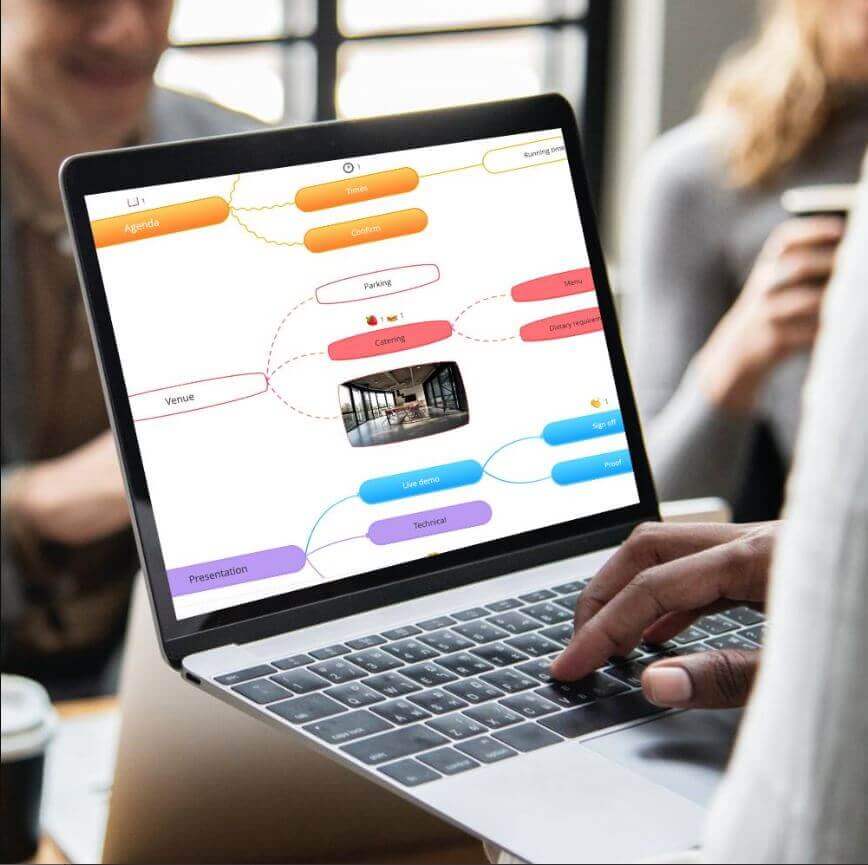January 15, 2020 (Updated March 7th, 2023)
Mind Maps for pre and post-assessment

Using Mind Maps for the pre and post-assessment of students’ learning is a practical and transparent form of measuring topic adoption, enjoyed by students and teachers alike. In this article, we take a look at the benefits of using Mind Maps for pre and post-assessment and how you can best apply this powerful creative thinking and organizational tool to this process.
What is Mind Mapping and how does it aid learning?
Mind Mapping is a visual interpretation of your thoughts and ideas, arranged around a central topic or theme. It is used in thousands of schools, universities and colleges worldwide to aid comprehension, memory, creativity and innovation. Mind Mapping is commonly used in education as it allows students the freedom to interpret topics in their own way and make their own connections between ideas. The use of images, colors and keywords also ensure that students commit the information they Mind Map to memory, making it ideal to be used in assessment.

What are the benefits of Mind Mapping for assessment?
Mind Mapping is a great tool for assessment of students’ pre and post-learning to accurately gauge the knowledge they have absorbed. Essentially, students make a Mind Map before and after they have been taught a particular topic to determine what has been learned. This is an effective assessment of topic adoption. Mind Maps allow students to interpret and express ideas metaphorically, and as a method of assessment, it does not rely on your students’ language levels. Therefore, this gives a more accurate picture of the knowledge they have amassed. Plus, it allows students to display their contextual knowledge and requires deeper insight, as they make connections between topics and subsequent sub-topics.
The understanding measured by using Mind Mapping for assessment is transparent and realistic, based on actual knowledge learned rather than language or written skills. More importantly, unlike traditional assessments, students actually enjoy the process!
Will Mind Mapping for assessment be applicable for all of my students?
Mind Mapping for pre and post-assessment is suitable for a whole range of students as it encompasses a variety of techniques that can be adapted to suit any preferred style of learning. For visual and kinaesthetic learners, it makes it easier to express their ideas in a non-linear, colorful and image-filled way. It is particularly helpful for dyslexic students, who can find taking assessments via traditional methods frustrating and even demoralizing, as this is often based solely upon language levels. However, using Mind Mapping for assessments is also stimulating for students who prefer more traditional styles of learning, as Mind Mapping does not place a pre-defined ‘ceiling’ on how far they can take an exercise or how much knowledge they can display.
How do I apply Mind Mapping to pre and post-assessment?
There are two ways in which you can practically apply Mind Mapping to pre and post-assessments. The first is for older or more able students to try:
- First, introduce the topic to your students, and ask them as a pre-assessment to Mind Map their initial thoughts and responses. They can take these initial ideas from anywhere; the media, other parts of the curriculum, their own interpretations, etc.
- After the pre-assessment, teach the topic to your students, who can use their initial Mind Maps as a reference for how much their knowledge is growing.
- Finally, as the post-assessment, ask your students to create a summative assessment Mind Map, even using their initial Mind Maps as a template. They should be able to add in much more accurate detail, plus make sophisticated connections between areas of the topic and show evidence of independent thinking (which is looked for in formal exam marking criteria). Once you have reviewed this post-assessment of topic adoption, the students can use their summative Mind Maps as a rich source of supportive evidence, ideal for revision or topic reviews.
The second application of Mind Mapping for pre and post-assessment is more suitable for younger students, or less able pupils:
- For the pre-assessment, make this an inclusive class exercise and create a group Mind Map, so you can capture everyone’s initial ideas and opinions – this task is ideal on a whiteboard or collaborative Mind Mapping tool such as Ayoa. This approach really fires up younger students’ imaginations and is a great way to include everyone.
- Following the pre-assessment, and after you have taught your students the topic, you can discuss the class’ original ideas and then restructure this Map to assess their knowledge. This method of assessment involves including a sample of the topic information your students have been taught in a random Mind Map structure around the central idea. From here, ask your students to make the correct connections between these ideas and supply their own understanding to rearrange the Map. For example, with a Map on French vocabulary, you could place different images around the Map and get your students to place these next to the correct words or phrases.
- By using this ‘restructured’ Mind Map, the students can participate in self-assessment to measure the accuracy and depth of the knowledge they have acquired. More able students will be comfortable with the task, whilst less able students may require support or further instruction.
Why Ayoa makes pre and post-assessment less complicated
Ayoa offers powerful and dynamic Mind Mapping features that can be used for pre and post-assessment. For example, if you want to turn your Mind Maps into templates for your students, the process couldn’t be easier – simply head to your Mind Map settings to save it as a template to reuse again and again.
In the post-assessment exercise, your students can attach files, documents and web links, as well as audio and video files onto their Map to further display their knowledge. For coursework purposes, students can export their self-assessment Maps as a PDF to showcase their work. Plus, younger students will love that they can print their assessment Maps off to use as study posters.
Younger students will love using the variety of colors, Central Idea stickers and branch styles in Ayoa’s Mind Maps, as this will capture their imagination for the group task. You can also use a variety of images from the Unsplash image library for the ‘restructuring the Map’ assessment – making life easy!
Visit our Mind Mapping for Education page to discover how you and your students can make the most out of Ayoa during your studies and teaching. Along with our basic, free plan, we also provide a 35% discount off our paid plans, so your students can unlock their greatest potential. Learn more about Mind Mapping in Ayoa here and get started for FREE today.
